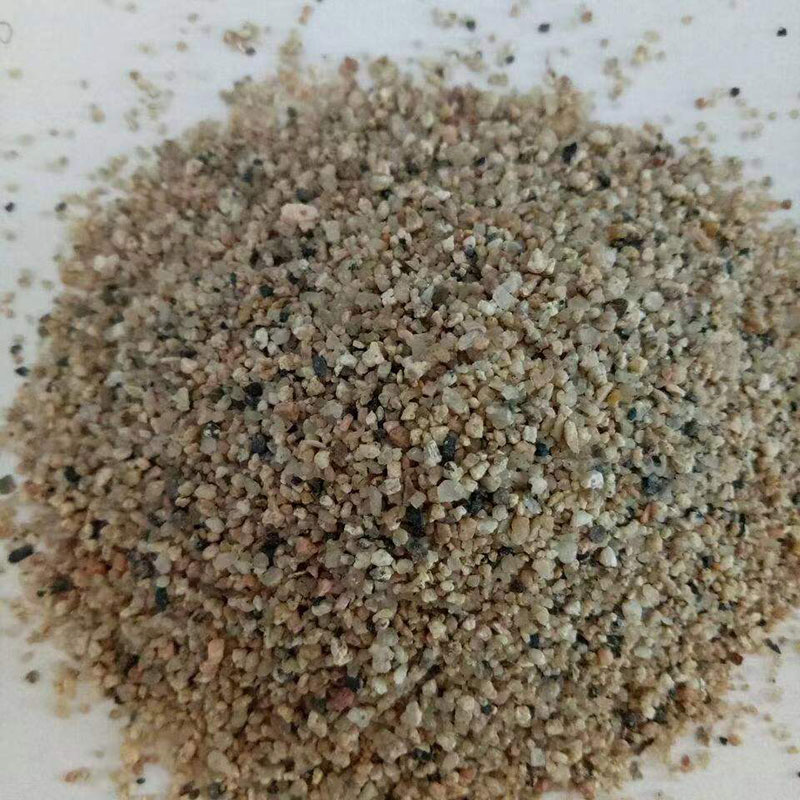Wholesale pet natural drying silica sand
Introduction to substances
Silica sand and quartz sand do not belong to the same kind of substances, both substances are silica as the main component, but quartz sand is a crystal, is prepared from quartz stone, silica sand is prepared from silica-containing sand and gravel, the appearance of the two is more different, the production method is also different, the reason why it is Chinese to be distinguished by the content percentage is because China's quartz sand is easier to obtain, in addition, China's quartz sand content is higher than China's silica sand content, so our country mistakenly called quartz sand also known as silica sand, or silica sand also known as quartz sand, It is the main raw material for making glass. Silica sand has ordinary silica sand, refined silica sand and high-purity silica sand. The content of silica in ordinary silica sand is between 90% and 99%, and the iron oxide content is less than 0.02%; The content of silica in refined silica sand is between 99% and 99.5%, and the iron oxide content is less than 0.015%; The silica content in high-purity quartz sand is between 99.5% and 99.9%, and the iron oxide content is less than 0.001%. Silica sand with higher purity is milky white, when the impurity content is more, silica sand will appear brownish-red, light brown and other colors, the melting point of silica sand is about 1750 °C, the particle size is between 0.02mm ~ 3.35mm, insoluble in acids other than hydrofluoric acid, with good chemical stability, electrical insulation, wear resistance and other characteristics. Most of the world's major glass producing countries, such as the Soviet Union, the United States, Belgium and other countries, use natural silica sand. The quality of natural silica sand in China is relatively poor, and silica sand processed by quartz sandstone crushing is generally used as the raw material for glass.
As the core raw material of silicon raw materials, silica plays an irreplaceable and important basic role in the production and supply of silicon raw materials. It has unique physical and chemical characteristics, so that it occupies a pivotal position in aviation, aerospace, electronics, machinery and today's rapidly developing IT industry, especially its internal molecular chain structure, crystal shape and lattice change law, so that it has high temperature resistance, small thermal expansion coefficient, high insulation, corrosion resistance, piezoelectric effect, resonance effect and its unique optical properties, making it play an increasingly important role in many high-tech products, such as the core technology products of the IT industry - Computer chips, optical fibers, resonators for the electronics industry, new electric light sources, high-insulation sealing materials, aerospace instruments, military technology products, special optical glasses, chemical analysis instruments, etc., are inseparable from these basic raw materials.
Silica sand
Natural silica sand is divided into washed sand, scrubbed sand, selected (flotation) sand, etc., washed sand is mainly used in the casting industry, scrubbing sand is mainly used in the production of architectural grade glass and glass containers, flotation sand is the raw material for the production of float glass.
Common specifications
Common specifications of silica sand are: 1-2mm, 2-4mm, 4-8mm, 8-16mm, 16-32mm, 10-20 mesh, 20-40 mesh, 40-80 mesh, 100-120 mesh, 200 mesh, 325 mesh, SiO2≥99-99.5% Fe2O3≤0.02-0.015%.
Application areas
Silica sand is an important industrial mineral raw material, widely used in glass, casting, ceramics and refractories, metallurgy, construction, chemical industry, plastics, rubber, abrasives and other industries.
1. Glass: flat glass, float glass, glass products (glass jars, glass bottles, glass tubes, etc.), optical glass, glass fiber, glass instruments, conductive glass, glass cloth and anti-ray special glass are the main raw materials
2. Ceramics and refractory materials: blanks and glazes of porcelain, high silicon bricks for kilns, ordinary silicon bricks and raw materials for silicon carbide.
3. Metallurgy: raw materials or additives and fluxes of silicon metal, ferrosilicon alloy and silicon aluminum alloy
4. Construction: concrete, cementitious materials, road construction materials, artificial marble, cement physical property inspection materials (i.e. cement standard sand), etc. 5. Chemical industry: raw materials such as silicon compounds and water glass, fillers for sulfuric acid towers, amorphous silica powder
6. Machinery: the main raw materials of casting sand, grinding materials (sandblasting, hard grinding paper, sandpaper, emery cloth, etc.)
7. Electronics: high-purity silicon metal, optical fiber for communication, etc
8. Rubber, plastic: filler (can improve wear resistance)
9. Coating: filler (can improve the acid resistance of the coating)
10. Aviation, aerospace: its intrinsic molecular chain structure, crystal shape and lattice change law, and has high temperature resistance, small thermal expansion coefficient, corrosion resistance, high insulation, piezoelectric effect, resonance effect and its unique optical characteristics.
Industrial applications
1. Application in glass: according to the content of silica sand, purity and chemical composition of glass, silica sand can be made of different types of glass, such as ordinary soda-lime silica glass, color glass with colorant, optical glass that can change the direction of light propagation, special glass with special functions, thermal insulation glass, vacuum glass, conductive glass, as well as glass instruments made of glass, daily utensils, such as glasses, glasses, microwave oven turntables, mobile phone screens, etc.
2, in the application of ceramics: the whiteness of ceramics has a very important impact on the quality of ceramics, in order to improve its whiteness, you can add some silica sand to the ceramic raw materials, and after adding silica sand, you can also reduce the drying time of the ceramic green body, avoid cracking caused by slow drying, at the same time, after adding silica sand, the surface peeling phenomenon of the ceramic will disappear, so the addition of silica sand greatly improves the quality of ceramics. In addition to the application of silica sand in ceramics, silica sand can also be finely ground to make silica sand into powder, which is used for the preparation of enamel, and the preparation of enamel has higher requirements for the purity of silica sand.
3.Application in casting: silica sand has relatively special properties in physics, such as thermal shock resistance, hardness and other characteristics, so it has great applications in the casting of mold cores and molds. When making ceramics, the chemical composition requirements of silica sand are relatively high, but casting has higher requirements for the physical properties of silica sand, such as the particle size and shape of silica sand particles.
4. Application in aerospace: Because silica sand has good piezoelectric effect, high insulation, corrosion resistance, high temperature resistance and other properties, it is not available in other materials, so it has very important applications in aviation and aerospace.
5, construction applications: silica sand in the construction of the application is the most common, such as in the construction of houses and roads, to cement, concrete to add a certain proportion of sand, can make the wall, road more strong, to prevent the appearance of cracks, silica sand applied to the building, there are certain requirements for particle size, such as in the construction of houses, silica sand mixed with cement before the sand screen is uniform, so there are certain requirements for the physical properties of silica sand.
6.Other applications: In addition to the application of silica sand in glass, ceramics, casting, construction, etc., there are some other special applications, such as being used as abrasive materials such as sandpaper and gauze; Adding silica sand to plastics can improve the wear resistance of plastics; Quartz photofibers made of silica are the skeleton of the information superhighway; quartz cuvettes, quartz crucibles, etc. used in laboratories; Agate ornaments made from agates with colored layers or rings in quartz.
Applications in the field of the environment
Another important use of silica sand is as a filter material and filter tank for water treatment. With the development of China's economy, various factories continue to appear, and the problem of water pollution continues to emerge: industrial wastewater is discharged arbitrarily, urban garbage is piled into the river, and pesticides sprayed in rural areas flow into the river with rainwater, etc., resulting in many harmful substances in the water, and human beings cannot drink these seriously polluted water. Some of China's industrial wastewater is directly discharged into the river without treatment, and some treated wastewater is directly discharged into the river if it does not meet the national standard, and the treatment capacity of sewage is very low. In response to this situation, China has carried out many studies, and various nanomaterials, porous carbon materials, etc. that can adsorb harmful metal ions and organic matter in wastewater have been continuously studied. The use of solid adsorbents to remove harmful ions in wastewater is an important means of wastewater treatment, but the regeneration of used adsorbents has become a problem. Moreover, adsorbents with good effects are expensive and cannot be universally applied to daily life. Silica sand is widely distributed and cheap, and the study of adsorbents with silica sand as the main component provides a basis for solving the problem of water pollution. Therefore, using silica sand as raw material to study its surface condition, adsorption performance and other properties is of great significance for treating water pollution and improving the environment.








